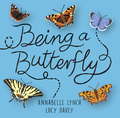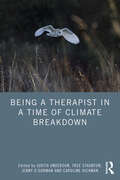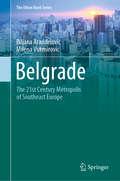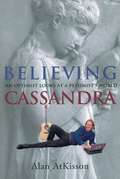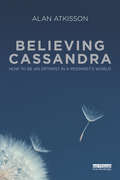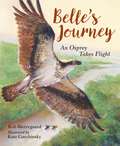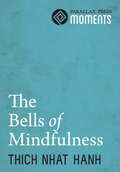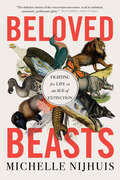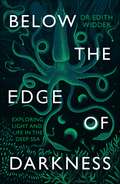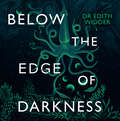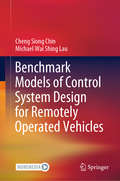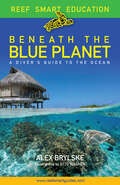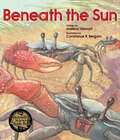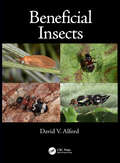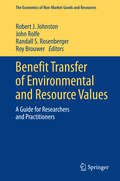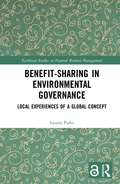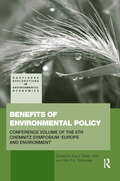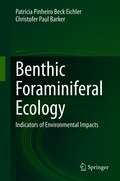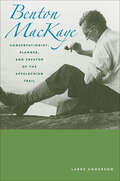- Table View
- List View
Being a Bee
by Jinny JohnsonBuzz into Being a Bee to discover more about this incredible insect.Buzzing from flower to flower, and making delicious honey to eat, bees have endless child appeal. But there's even more to bees than meets the eye... Buzz into Being a Bee to discover more about this incredible insect. Children will love learning about life in the hive, bee families, and how older bees work together to look after and raise baby bees. They can find out about beekeeping, how and why bees make honey, and how they dance to communicate with other bees.The book also gently introduces children to the idea of conservation - explaining why bees are in danger, the need to protect them, and all the ways we can help, from planting wild flowers to buying local honey. Gentle engaging text, and bright, captivating artwork will ensure children finish the book as bee experts!
Being a Butterfly (Being a Minibeast #3)
by Annabelle LynchDiscover how a caterpillar transforms into a bright, beautiful butterfly in this wonderfully illustrated picture bookBeing a Butterfly brings a butterfly's brief, precious life cycle to beautiful life. Follow the story of a little green caterpillar as it hatches, grows and transforms itself into a bright, colourful butterfly. Learn how butterflies move, feed themselves and pollinate flowers, before finding a mate and beginning the whole cycle of life again.This wonderfully illustrated picture book is a perfect introduction to life cycles for readers aged 5 and up. It also gently introduces them to the idea of conservation.List of contents: Left on a leafHatching outA greedy caterpillarShedding skinTime to restChanging timesA beautiful butterflyLearning to flyFinding flowers Billions of butterfliesFinding a mateNew eggsProtecting butterfliesGlossaryFind out more
Being a Therapist in a Time of Climate Breakdown
by Judith Anderson Caroline Hickman Tree Staunton Jenny O’GormanThis book introduces readers to the known psychological aspects of climate change as a pressing global concern and explores how they are relevant to current and future clinical practice.Arguing that it is vital for ecological concerns to enter the therapy room, this book calls for change from regulatory bodies, training institutes and individual practitioners. The book includes original thinking and research by practitioners from a range of perspectives, including psychodynamic, eco-systemic and integrative. It considers how our different modalities and ways of working need to be adapted to be applicable to the ecological crises. It includes Voices from people who are not practitioners about their experience including how they see the role of therapy. Chapters deal with topics from climate science, including the emotional and mental health impacts of climate breakdown, professional ethics and wider systemic understandings of current therapeutic approaches. Also discussed are the practice-based implications of becoming a climate-aware therapist, eco-psychosocial approaches and the inextricable links between the climate crises and racism, colonialism and social injustice. Being a Therapist in a Time of Climate Breakdown will enable therapists and mental health professionals across a range of modalities to engage with their own thoughts and feelings about climate breakdown and consider how it both changes and reinforces aspects of their therapeutic work.
Being the Change: Live Well and Spark a Climate Revolution
by Peter Kalmus&“A plethora of insights about nature and ourselves, revealed by one man&’s journey as he comes to terms with human exploitation of our planet.&” —Dr. James Hansen, climate scientist and former director of NASA&’s Goddard Institute for Space Studies Life on one-tenth the fossil fuels turns out to be awesome. We all want to be happy. Yet as we consume ever more in a frantic bid for happiness, global warming worsens. Alarmed by drastic changes now occurring in the Earth&’s climate systems, Peter Kalmus, a climate scientist and suburban father of two, embarked on a journey to change his life and the world. He began by bicycling, growing food, meditating, and making other simple, fulfilling changes. Ultimately, he slashed his climate impact to under a tenth of the US average and became happier in the process.Being the Change explores the connections between our individual daily actions and our collective predicament. It merges science, spirituality, and practical action to develop a satisfying and appropriate response to global warming. Part one exposes our interconnected predicament: overpopulation, global warming, industrial agriculture, growth-addicted economics, a sold-out political system, and a mindset of separation from nature. It also includes a readable but authoritative overview of climate science. Part two offers a response at once obvious and unprecedented: mindfully opting out of this broken system and aligning our daily lives with the biosphere. The core message is deeply optimistic: living without fossil fuels is not only possible, it can be better. &“In this timely and provocative book, Peter Kalmus points out that changing the world has to start with changing our own lives. It&’s a crucial message that needs to be heard.&” —John Michael Greer, author of After Progress and The Retro Future
Belgrade: The 21st Century Metropolis of Southeast Europe (The Urban Book Series)
by Biljana Arandelovic Milena VukmirovicThis book highlights Belgrade, reviewing its recent and historical developments and emphasizing its major ongoing planning projects. The book is divided into eight chapters. The first, entitled The urban, political and socioeconomic rise and fall of Belgrade through its history, introduces the reader to the city, and is followed by a chapter on Belgrade’s urban plans through history. The book continues with a chapter on one of the major urban projects in the former Yugoslavia, the construction of New Belgrade, its development and results, entitled New Belgrade: from no man’s land to modern city. In turn, the following three chapters explore three dominant contemporary topics: Belgrade’s riverfront redevelopment; Reimaging Belgrade: the case of Savamala; and Sustainable Belgrade. Expansion of the pedestrian zone in the city center. The book draws to a close with a chapter on Future predictions: South-Eastern European metropolis of the 21st century. This chapter in particular discusses large city projects and includes predictions about the city’s future.
Believers: Making a Life at the End of the World
by Lisa WellsIn search of answers and action, the award-winning poet and essayist Lisa Wells brings us Believers, introducing trailblazers and outliers from across the globe who have found radically new ways to live and reconnect to the Earth in the face of climate change We find ourselves at the end of the world. How, then, shall we live?Like most of us, Lisa Wells has spent years overwhelmed by increasingly urgent news of climate change on an apocalyptic scale. She did not need to be convinced of the stakes, but she could not find practical answers. She embarked on a pilgrimage, seeking wisdom and paths to action from outliers and visionaries, pragmatists and iconoclasts. Believers tracks through the lives of these people who are dedicated to repairing the earth and seemingly undaunted by the task ahead.Wells meets an itinerant gardener and misanthrope leading a group of nomadic activists in rewilding the American desert. She finds a group of environmentalist Christians practicing “watershed discipleship” in New Mexico and another group in Philadelphia turning the tools of violence into tools of farming—guns into ploughshares. She watches the world’s greatest tracker teach others how to read a trail, and visits botanists who are restoring land overrun by invasive species and destructive humans. She talks with survivors of catastrophic wildfires in California as they try to rebuild in ways that acknowledge the fires will come again. Through empathic, critical portraits, Wells shows that these trailblazers are not so far beyond the rest of us. They have had the same realization, have accepted that we are living through a global catastrophe, but are trying to answer the next question: How do you make a life at the end of the world? Through this miraculous commingling of acceptance and activism, this focus on seeing clearly and moving forward, Wells is able to take the devastating news facing us all, every day, and inject a possibility of real hope. Believers demands transformation. It will change how you think about your own actions, about how you can still make an impact, and about how we might yet reckon with our inheritance.
Believing Cassandra: An Optimist Looks at a Pessimist's World
by Alan AtkissonAtKisson sees concerned citizens and scientists who view the world hurtling toward self-destruction. Is it true that most of the human race could care less about their dire warnings?
Believing Cassandra: How to be an Optimist in a Pessimist's World
by Alan AtKissonA bestseller on Amazon.com within months of its first release, Alan AtKisson's debut book quickly became a modern classic of sustainability literature. Global companies, grassroots groups, university courses, government agencies, and even the US Army ordered it by the box. Now fully revised and updated, Believing Cassandra: How to be an Optimist in a Pessimist's World is even more relevant, fresh, and motivating than when it first appeared in 1999. In a style that's refreshingly candid and vivid, with unforgettable personal anecdotes, AtKisson provides us with a bridge over the sea of despair, and shows us how to catch the wave to an enticing, sustainable future. He empowers the reader to join the pioneers who created the ideas, techniques and practices of sustainable living - the people who prove Cassandra's warnings wrong, by believing in them, and taking strategic action.
Belle's Journey: An Osprey Takes Flight
by Rob BierregaardTake flight with Belle, an osprey born on Martha's Vineyard as she learns to fly and migrates for the first time to Brazil and back--a journey of more than 8,000 miles.Dr. B. and Dick, two osprey scientists in Massachusetts, observe ospreys and their offspring, tagging one special fledgling with a transmitter to better study migration habits. Follow Belle as she attempts her first flight, conquers her first fishing endeavour, and heads south for her first migration all while her tracking device transmits information about where's she been. Based on information garnered through twenty years of research by the author, Belle's Journey will soar into reader's hearts.
Bells of Mindfulness
by Thich Nhat HanhThe Bells of Mindfulness is part of the Parallax Press Moments series of short ebooks. Thich Nhat Hanh presents a dramatic vision of the future of our planet, a call for environmental awareness, and Buddhist teachings on interconnectedness. Ultimately, Nhat Hanh believes that engaging with the world is the key to our individual and collective survival. Selected from his best-selling title The World We Have.
Beloved Beasts: Fighting For Life In An Age Of Extinction
by Michelle NijhuisOne of Literary Hub's Most Anticipated Books of 2021 A vibrant history of the modern conservation movement—told through the lives and ideas of the people who built it. In the late nineteenth century, as humans came to realize that our rapidly industrializing and globalizing societies were driving other animal species to extinction, a movement to protect and conserve them was born. In Beloved Beasts, acclaimed science journalist Michelle Nijhuis traces the movement’s history: from early battles to save charismatic species such as the American bison and bald eagle to today’s global effort to defend life on a larger scale. She describes the vital role of scientists and activists such as Aldo Leopold and Rachel Carson as well as lesser-known figures in conservation history; she reveals the origins of vital organizations like the Audubon Society and the World Wildlife Fund; she explores current efforts to protect species such as the whooping crane and the black rhinoceros; and she confronts the darker side of conservation, long shadowed by racism and colonialism. As the destruction of other species continues and the effects of climate change escalate, Beloved Beasts charts the ways conservation is becoming a movement for the protection of all species—including our own.
Below the Edge of Darkness: Exploring Light and Life in the Deep Sea
by Edith Widder'A book of marvels, marvellously written' RICHARD DAWKINSA pioneering marine biologist takes us down into the deep ocean to understand bioluminescence, the language of light that helps life communicate in the darkness, and what it tells us about the future of life on Earth.Edith Widder grew up determined to become a marine biologist. But after complications from a surgery during college caused her to go temporarily blind, she became fascinated by light as well as the power of optimism. Her focus turned to oceanic bioluminescence, a scientific frontier, and with little promise of funding or employment she took a leap into the dark. Below the Edge of Darkness explores the depths of the planet's oceans as Widder seeks to understand one of the most important and widely used forms of communication in nature. In the process, she reveals hidden worlds and a dazzling menagerie of behaviours and animals, many never-before-seen or, like the legendary Giant Squid, never-before-filmed in its deep-sea lair. Alongside Widder, we experience life-and-death equipment malfunctions and witness breakthroughs in technology and understanding, all of it set against a growing awareness of the deteriorating health of our largest and least understood ecosystem.This is an adventure story as well as a science story. But it's also about the sometimes complicated business of exploration. And ultimately, Widder shows us that exploration, and the corresponding senses of discovery and wonder, are the keys to the ocean's salvation and thus our future on this planet.'Edie's story is one of hardscrabble optimism, two-fisted exploration and groundbreaking research. As I've said many times, I'd have wrapped my submersible, the DEEPSEA CHALLENGER, in bacon if it would have lured the elusive giant squid from the depths. In Below the Edge of Darkness, Edie tells you how she did it' JAMES CAMERON
Below the Edge of Darkness: Exploring Light and Life in the Deep Sea
by Edith WidderA pioneering marine biologist takes us down into the deep ocean in this 'thrilling blend of hard science and high adventure' (The New York Times)Edith Widder grew up determined to become a marine biologist. But after complications from a surgery during college caused her to go temporarily blind, she became fascinated by light as well as the power of optimism. Below the Edge of Darkness explores the depths of the planet's oceans as Widder seeks to understand bioluminescence, one of the most important and widely used forms of communication in nature. In the process, she reveals hidden worlds and a dazzling menagerie of behaviours and animals. Alongside Widder, we experience life-and-death equipment malfunctions and witness breakthroughs in technology and understanding, all of it set against a growing awareness of the deteriorating health of our largest and least understood ecosystem.'A vivid account of ocean life' ROBIN MCKIE, GUARDIAN BOOK OF THE DAY'Edie's story is one of hardscrabble optimism, two-fisted exploration and groundbreaking research. She's done things I dream of doing' JAMES CAMERON'A book of marvels, marvellously written' RICHARD DAWKINS
Benchmark Models of Control System Design for Remotely Operated Vehicles
by Cheng Siong Chin Michael Wai LauThis book is intended to meet the needs of those who seek to develop control systems for ROVs when there is no model available during the initial design stage. The modeling, simulation and application of marine vehicles like underwater robotic vehicles (URVs) are multidisciplinary, and combine mathematical aspects from various engineering disciplines. URVs such as remotely operated vehicle (ROVs) are used for a wide range of applications such as exploring the extreme depths of our ocean, where a hard-wired link is still required. Most ROVs operate in extreme environments with uncertainties in the model prior to control system design. However, the method involved extensive testing before the system model could be used for any control actions. It has been found that the range of error can be extensive and uncertain in actual, continuously varying conditions. Hence, it is important to address the problem of reliance on model testing using different modeling approaches. In this book, approaches such as WAMIT, ANSYS-CFX, STAR CCM+, MATLAB and Simulink are used to model parameters for ROVs. A few benchmark models are provided, allowing researchers and students to explore and test different control schemes. Given its scope, the book offers a valuable reference guide for postgraduate and undergraduate students engaged in modeling and simulation for ROV control.
Beneath the Blue Planet: A Diver's Guide to the Ocean and Its Conservation (Reef Smart Education)
by Alex BrylskeTake a Deep Dive into the Secrets of Our Blue Planet"The author is one of the most experienced in the world. A fascinating and engaging toom. Well worth the read. A valued forever reference." —Amazon review#1 New Release in Scuba Travel GuidesVenture into the thrilling realm of underwater exploration with Beneath the Blue Planet by the founders of the popular Reef Smart Guides series for snorkelers and scuba divers. A perfect travel gift for nature lovers and a rich source of shark facts, this book unearths the secrets of the ocean, from coral reefs to the world of deep diving.Dive into the ocean's untold stories. Discover the captivating universe that exists beneath the waves. From the diverse inhabitants of the coral reefs to the deepest, most mysterious corners of the ocean, Beneath the Blue Planet unveils everything you've ever wanted to know about our underwater world.Experience the thrill of ocean exploration. This immersive guide provides fascinating shark facts, explores the incredibly beautiful world of coral reefs, and encourages sustainable tourism for divers. Designed for anyone who loves the ocean, this book is a treasure trove of knowledge, making it an excellent travel gift for adventure seekers.Immerse yourself in Beneath the Blue Planet and:Unearth the hidden world of ocean reefs, and understand their essential role in marine ecosystemsGain invaluable insights into snorkeling and deep diving, enhancing your ocean exploration adventuresExplore intriguing shark facts, providing a closer look at these fascinating marine creaturesDiscover practical ways to contribute to ocean conservation, turning your love for the seas into meaningful actionIf you've read Oceanology, National Geographic A Diver's Guide to the World, or100 Dives of a Lifetime, and are a fan of the Reef Smart Guides dive and snorkel travel series, you’ll love Beneath the Blue Planet.
Beneath the China Boom: Labor, Citizenship, and the Making of a Rural Land Market
by Julia ChuangFor nearly four decades, China’s manufacturing boom has been powered by the labor of 287 million rural migrant workers, who travel seasonally between villages where they farm for subsistence and cities where they work. Yet recently local governments have moved away from manufacturing and toward urban expansion and construction as a development strategy. As a result, at least 88 million rural people to date have lost rights to village land. In Beneath the China Boom, Julia Chuang follows the trajectories of rural workers, who were once supported by a village welfare state and are now landless. This book provides a view of the undertow of China’s economic success, and the periodic crises—a rural fiscal crisis, a runaway urbanization—that it first created and now must resolve.
Beneath the Lines: Borders and Boundary-Making from the 18th to the 20th Century (Historical Geography and Geosciences)
by Jacobo García-Álvarez Paloma Puente-LozanoThis book brings together ten empirically rich and theoretically informed contributions that aim to clarify both geo-historical specificities and common transnational and global features of the cultures and practices of boundary making that shaped modern statehood. Written by scholars from Spain, France, Italy, Argentina, Brazil and Mexico, the essays included in this volume provide a comparative international perspective on the processes of border formation, as well as an integrative approach that seeks to strengthen the links between renewed geo-historical studies and more contemporary-oriented border studies. The book is addressed to a wide range of researchers, including geographers, historians, political scientists and specialists in geopolitics and the history of international relations.
Beneath the Sun
by Melissa StewartThis lyrical tour of a variety of habitats offers young readers vivid glimpses of animals as they live out the hot season under the blazing sun.When the sun is shining brightly, people put on sunscreen or scurry inside to cool off. But how do wild animals react to the sizzling heat? Journey from your neighborhood to a field where an earthworm loops its long body into a ball underground, to a desert where a jackrabbit loses heat through its oversized ears, to a wetland where a siren salamander burrows into the mud to stay cool, and to a seashore where a sea star hides in the shade of a seaweed mat. Constance R. Bergum's glowing watercolors perfectly capture the wonder of a hot, sunny environment.
Beneficial Insects
by David AlfordInsects are key components of life on our planet, and their presence is essential for maintaining balanced terrestrial ecosystems. Without insects humans would struggle to survive, and on a world scale food production would be severely compromised. Many plants and animals depend directly or indirectly on insects for their very survival, and this is particularly so in the case of insectivorous birds and other such creatures. The beneficial role of insects is often overlooked or misunderstood, and in farming circles their very presence on crops is often seen to be unwelcome. In reality, however, many insects are genuinely beneficial, as in the case of parasitic and predacious species. The use of chemical pesticides to control crop pests is becoming more tightly regulated and environmentally undesirable, and low-input farming, in which natural enemies of pests are encouraged to survive or increase, is becoming far more prevalent. Accordingly, Integrated Pest Management (IPM) and Integrated Pest Management (ICM) strategies are increasingly being developed, advocated and adopted. <p><p>Features: <li>Highlights information on many groups of insects and mites that act as natural enemies or biological control agents of phytophagous insects and mites, including plant pests. <li>Profusely illustrated with high-quality colour photographs. <li>Focuses mainly on insects and mites as natural enemies of plant pests, including parasitic and predacious species that have been accidentally or deliberately introduced in classical biological control programmes. <li>Reviews the role of phytophagous European insects and mites in controlling or managing European plants that have become invasive weeds in other parts of the world, notably North America, Australia and New Zealand.
Benefit Transfer of Environmental and Resource Values: A Guide for Researchers and Practitioners (The Economics of Non-Market Goods and Resources #14)
by John Rolfe Roy Brouwer Robert J. Johnston Randall S. RosenbergerThis book provides a comprehensive review of environmental benefit transfer methods, issues and challenges, covering topics relevant to researchers and practitioners. Early chapters provide accessible introductory materials suitable for non-economists. These chapters also detail how benefit transfer is used within the policy process. Later chapters cover more advanced topics suited to valuation researchers, graduate students and those with similar knowledge of economic and statistical theory and methods. This book provides the most complete coverage of environmental benefit transfer methods available in a single location. The book targets a wide audience, including undergraduate and graduate students, practitioners in economics and other disciplines looking for a one-stop handbook covering benefit transfer topics and those who wish to apply or evaluate benefit transfer methods. It is designed for those both with and without training in economics
Benefit-sharing in Environmental Governance: Local Experiences of a Global Concept (Earthscan Studies in Natural Resource Management)
by Louisa ParksTaking a bottom-up perspective, this book explores local framings of a wide range of issues related to benefit-sharing, a growing concept in global environmental governance. Benefit-sharing in Environmental Governance draws on original case studies from South Africa, Namibia, Greece, Argentina, and Malaysia to shed light on what benefit-sharing looks like from the local viewpoint. These local-level case studies move away from the idea of benefit-sharing as defined by a single international organization or treaty. Rather, they reflect different situations where benefit-sharing has been considered, including agriculture, access to land and plants, wildlife management, and extractives industries. Common themes in the experiences of local communities form the basis for an exploration of spaces for local voices at the international level in the Convention on Biological Diversity (CBD), often argued to be the most open arena to non-state actors, and therefore vital to how local voices may be included at the global level. The book analyzes the decisions of the CBD parties to produce an in-depth reflection on how this arena builds and delimits spaces for the expression of local community themes, and paths for local community participation including community protocols. The book then situates the bottom-up findings in the wider debate about global civil society and deliberative democracy in environmental governance. This interdisciplinary book will be of great interest to students and scholars of environmental politics, environmental law, political ecology and global governance, as well as practitioners and policymakers involved in multilateral environmental agreements.
Benefits of Environmental Policy: Conference Volume of the 6th Chemnitz Symposium 'Europe and Environment' (Routledge Explorations in Environmental Economics)
by Dirk Rübbelke Klaus Dieter JohnEnvironmental policy may produce effects which go beyond the scope of the specific policy’s initial aim. Reforestation, for example, generates positive benefits not only in the shape of climate protection but also in the shape of the combat of biodiversity loss and it may also raise the attractiveness of a region for tourists. There are several examples of environmental policies, generating initially unintended co-effects. These co-effects are not always positive, of course. This book addresses the wide range of (co-)effects associated with environmental policies which may increase or decrease the attractiveness of these policies. Therefore, the book’s scope goes beyond the standard economic analyses, which regularly postulate a specific cause-and-effect chain. The complexity and wide range of benefits is investigated from different perspectives and by means of different methodologies. Among the environmental policies discussed are climate mitigation policies as well as adaptation policies. The inclusion of all relevant effects of environmental policy (and therefore not only of the primarily intended effects) tends to have a strong impact on the efficient policy design. The areas which are covered by the book will be of great interest mainly for economists (environmental economics, ecological economics), ecologists and political scientists as well as practitioners, scientists and policy makers.
Benthic Foraminiferal Ecology: Indicators of Environmental Impacts
by Patrícia Pinheiro Beck Eichler Christofer Paul BarkerThis book provides effective statistical analyses in benthic foraminiferal communities patterns and show solutions for sea-land processes and alterations caused by climate changes and other local (and global) environmental concerns. Our goal is to provide, through these chapters, the monitoring and forecasting of environmental impacts with accurate data. We identify global regions most subject to industrial pollution, contamination and sewage, identifying potential sites prone to accumulate organic matter, which effects erosion, deposition, ocean temperature and pH changes (warming, cooling, acidification), climate and sea-level changes. Benthic habitats, specifically foraminiferal (single celled microorganisms found in the water column and sediment) contribute to our understanding of local and global climate change that effect at risk communities. Derived through the accuracy of oceanographic climate science, allow us to predict with the intention to alleviate potential loss in coastal areas, which are, the most vulnerable to ocean warming, cooling, acidification, and sea-level rise impacts. We unravel the mystery of the Environmental Impacts and Climate Change, helping communities prepare, adjust, adapt, and minimize effects or remediate loss. We show how to pinpoint the most vulnerable and specific sites for economic and social damage and loss, using foraminifera, an inexpensive and easily handled proxy valuable for monitoring coastal and marine environmental stressors.The implications of those problems and the ability to forecast patterns on land are primary issues we address by studying marine sediment of beaches, estuaries, bays and deep water worldwide. Ecology, biology, life history, and taxonomy of modern Foraminifera allows us to examine the current and historical record of environmental change effects, and predict implications for future sea-level rise, and ocean patterns. The prediction of responses of interacting systems to these problems, and development of strategies is needed to inform leadership with the knowledge and data to effectively implement policy, making this book a very informative and significant contribution for researchers and decision makers.
Benton MacKaye: Conservationist, Planner, and Creator of the Appalachian Trail (Creating the North American Landscape)
by Larry AndersonPlanner and originator of the Appalachian Trail and a cofounder of the Wilderness Society, Benton MacKaye (1879-1975) was a pioneer in linking the concepts of preservation and recreation. Spanning three-quarters of a century, his long and productive career had a major impact on emerging movements in conservation, environmentalism, and regional planning. MacKaye's seminal ideas on outdoor recreation, wilderness protection, land-use planning, community development, and transportation have inspired generations of activists, professionals, and adventurers seeking to strike a harmonious balance between human need and the natural environment.This pathbreaking biography provides the first complete portrait of this significant and unique figure in American environmental, intellectual, and cultural history. Drawing on extensive research, Larry Anderson traces MacKaye's extensive career, examines his many published works, and describes the importance of MacKaye's relationships with such influential figures as Lewis Mumford, Aldo Leopold, and Walter Lippmann. This book will appeal to students, scholars, and professionals in preservation, conservation, recreation, planning, and American studies, as well as general readers interested in these subjects.
Benton Mackaye: Conservationist, Planner, and Creator of the Appalachian Trail (Creating the North American Landscape)
by Larry AndersonThe life of the visionary conservationist who created the Appalachian Trail is chronicled in this &“first-rate biography of a unique American thinker&” (Mark Harvey, Journal of American History). Born in 1879, Wilderness Society cofounder Benton MacKaye was a pioneer in linking the concepts of preservation and recreation. Spanning three-quarters of a century, his career had a major impact on emerging movements in conservation, environmentalism, and regional planning. MacKaye's seminal ideas on outdoor recreation, wilderness protection, land-use planning, community development, and transportation have inspired generations of activists, professionals, and adventurers seeking to strike a harmonious balance between human need and the natural environment. This pathbreaking biography provides the first complete portrait of this significant figure in American environmental, intellectual, and cultural history. Drawing on extensive research, Larry Anderson traces MacKaye's extensive career, examines his many published works, and describes the importance of MacKaye's relationships with such influential figures as Lewis Mumford, Aldo Leopold, and Walter Lippmann.

